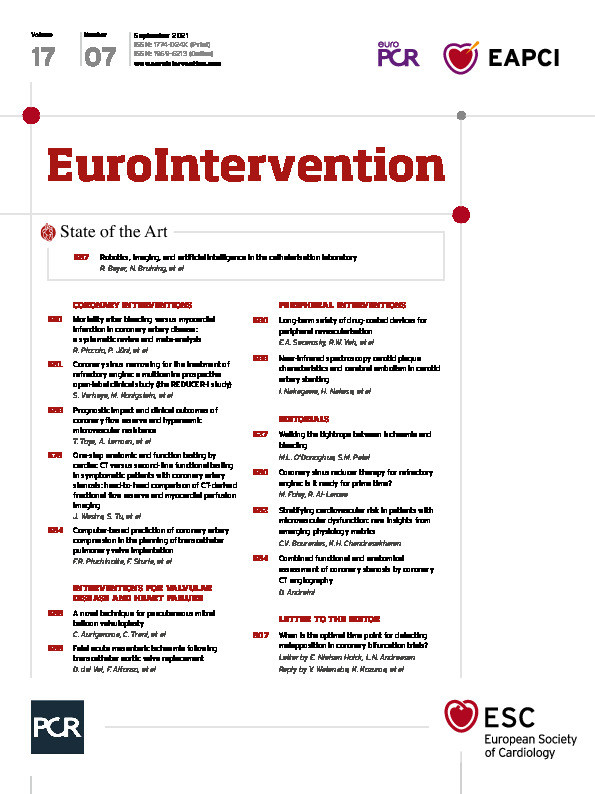The contemporary treatment of angina is centred around improving coronary arterial flow and increasing perfusion of ischaemic myocardium. This is variably achieved with medication, percutaneous coronary intervention (PCI) or coronary artery bypass grafting (CABG). The coronary sinus reducer (CSR; Neovasc Inc., Richmond, BC, Canada) is the only therapy which attempts to improve angina by acting on the postcapillary myocardial circulation. Unlike PCI, which has an intuitive, well-described, extensively investigated mechanism, how the CSR affects angina is not well understood.
The CSR is an hourglass-shaped, balloon-mounted, wire-mesh device that reduces the coronary sinus lumen, after inflammation and fibrosis have caused the device struts to close over time. It is postulated to have similar physiological effects to those seen in animal models of coronary sinus ligation, in which subendocardial perfusion and distal LAD pressure improved with coronary sinus ligation, in the setting of acute left anterior descending artery (LAD) infarction1,2. However, we know that myocardial infarction (MI) and stable coronary artery disease (CAD) are two separate entities which, whilst sharing common risk factors, represent distinct pathological processes. The story of PCI should make us cautions when extrapolating effects seen with the CSR in MI to stable CAD.
Importantly, there is placebo-controlled evidence of the efficacy of the CSR for symptom relief in patients with refractory angina. The Coronary Sinus Reducer for Treatment of Refractory Angina (COSIRA) trial randomised 104 patients with refractory angina to CSR or a placebo procedure3. An invasive blinding protocol was used, in which patients were offered a choice of either auditory isolation with headphones or medical sedation. The choice of either blinding technique with non-equivalent efficacies had the potential for the blinding to be compromised. Notably, the investigators did not report an assessment of the efficacy of blinding from patients or medical teams at discharge on the day of the procedure or follow-up. After a double-blinded follow-up period of six months, there was a significant improvement in the primary endpoint, with a higher proportion of patients improving by ≥2 Canadian Cardiovascular Society (CCS) classes in the CSR arm (18/52 [35%] vs 8/52 [15%] in the placebo arm).
Despite this result, in a patient group with few treatment options, the CSR is not widely utilised. This is in stark contrast to PCI and may be because the mechanism of action of the CSR is not well described. The means by which PCI may provide angina benefit is intuitive and obvious to physicians and patients alike, which makes the smaller than expected placebo-controlled effect size difficult to contemplate. In contrast, the mechanism of action of the CSR remains opaque; therefore, cardiologists remain sceptical of its value despite placebo-controlled evidence of symptom benefit.
In the current edition of EuroIntervention, the treatment of patients with angina using the CSR is reported in the open-label registry REDUCER-I study4.
The authors showed high procedural success rates (99%) and very favourable safety outcomes with this novel therapy (only one device-related major adverse cardiac event in 228 patients). They go on to report unblinded improvement in angina.
The most important additive finding of REDUCER-I is the real-world procedural success and safety of a new device. The unblinded symptom data should not inform our view of the efficacy of CSR beyond the placebo-controlled data which already exist. Notably, the mean CCS class improvement at six months in the blinded COSIRA study was similar to the unblinded REDUCER-I study (–1.1 CCS classes and –0.9 CCS classes, respectively). This finding is surprising because history has taught us that unblinded effect sizes are invariably larger than their blinded counterparts, due to inclusion of both physical and placebo components in the overall therapeutic effect size. The exceptionally rare finding of placebo-controlled benefit of a novel cardiac intervention should pique our scientific interest in this therapy, but we should scrutinise the blinding techniques of future CSR trials closely.
What is now required is replication of the placebo-controlled data and delineation of exactly how the counterintuitive obstruction of myocardial venous drainage provides symptom benefit to patients with angina. Does ischaemia actually improve with the CSR or will our conventional angina paradigm be challenged once again? Does the subendocardium benefit most, as suggested by the animal studies? Is there any effect on coronary flow or microvascular resistance with augmentation of venous outflow? Demonstration of efficacy must be matched with a plausible mechanistic narrative. The ongoing Coronary sinus reducer objective impact on symptoms, MRI Ischaemia and microvascular resistance (ORBITA-COSMIC) study may address this issue, by providing us with new mechanistic insights into the CSR in the setting of a placebo-controlled trial5. We also eagerly await the results of the COSIRA-II trial and hope that we will see consistency of blinding techniques and evidence of the way in which their efficacy was tested.
Is this therapy ready for prime time? That question can only be answered if we continue to see robust data that stand up to scientific scrutiny and allow us to make the right choices for an important and often overlooked clinical group.
Conflict of interest statement
M. Foley has received speaker's honoraria from Menarini Pharmaceuticals. R. Al-Lamee has received speaker's honoraria from Menarini Pharmaceuticals and Philips Volcano.
Supplementary data
To read the full content of this article, please download the PDF.

